 | E-mail to Birds Korea |
 | KWBS |
in the Region
 | The Oriental Bird Club |
 | BirdLife International (Asia) |
February
Cold winters mean both temperatures and birding are similar to January, while mild winters are marked by brief spells of rain or sleet, often followed by warmer sunshine, with maximum temperatures rising to 15°C in the southeast.
Many wildfowl are on the move by mid-month, including one or two Baer's Pochard. Tundra Beans, Greater White-fronted and usually Swan Geese can be found at the Han-Imjin. Most Baikal Teal start to depart and by month's end can be difficult to find in southern locations. Rooks and Daurian Jackdaws begin to move back into the Nakdong valley and near Gunsan. February sees the start of crane migration, with Hooded and White-napeds moving into South Korea from Japan. Relict and Saunders's Gull peak at several sites. In the right weather conditions large numbers of Ancient Murrelets and a few Rhinoceros Auklets move north off Guryongpo. At the end of the month the first migrants, such as Far Eastern Curlews, Hoopoes and Japanese Lesser Sparrowhawks start to arrive.
Highlights in February 2001 included a peak count of 143 Relict Gull at Song Do, in 2002, Korea's first Ferruginous Duck, and in 2003 White-crowned Sparrow in Busan, and Thayer's and American Herring Gull on the east coast.
In both 2004 and 2005 highlights included a Pallas's/Great Black-headed Gull (Korea's 3rd and 4th records). 2006 brought South Korea's first confirmed Brunnich's Guillemot, as well as records of Long-billed Dowitcher and Yellow-bellied Tit.
(The following records are a compilation of our own sightings and records sent in by other observers. As well as being posted on the Birds Korea website(s), selected records are also forwarded to other Korean-language birding websites; records of threatened species are arranged and forwarded to Birdlife International and national authorities when appropriate; flag images and records are passed to bodies responsible for their coordination throughout the flyway; and all records sent to us are used to compile annual reports and to support the evolving understanding of the status of many of Korea’s birds.)
Seoul/Eungbong, February 29
A very brief visit to the river and stream confluence at Eungbong. Rather fewer than usual ducks in the stream area: 30 odd Pintail, a dozen Northern Shovelers, a handful of Spot-billed Ducks, about 20 Tufted Ducks, a similar number of Common Teal, and a single Gadwall.


Paju, February 27
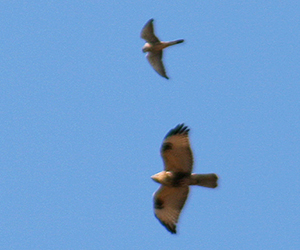
Rough-legged Buzzard Buteo lagopus
Photo © Mathew Poll
Warm, sunny and windy in Paju. Ducks seen on the river today included 8 Ruddy Shelduck, 9 Common Teal, ca 70 Spot-Billed Duck, ca 90 Mallard, and 6 Pintail. 3 pairs of Common Merganser mingled with the ducks. Several ‘V’ formations of Greater White Fronted Goose made slow and noisy passes over the nearby fields. 2 lugens White Wagtail paced the river banks, while 2 Cinereous Vulture circled high overhead. At least 5 Common Kestrel took turns hovering over the fields.
Interesting to watch was one of the Common Kestrel, flying wingtip to wingtip with what appeared to be an juvenile Rough-legged Buzzard for several minutes, before they parted ways. 2 Pallas’s Reed Bunting perched quietly atop some reeds next to the river. Several Far Eastern Lark were heard but not seen. Also seen were 5 Grey Heron, 7 Great Egret, and 5 Large-billed Crow. 2 possible Hill Pigeons were briefly seen under a bridge - I plan to return soon to get a better look at them.

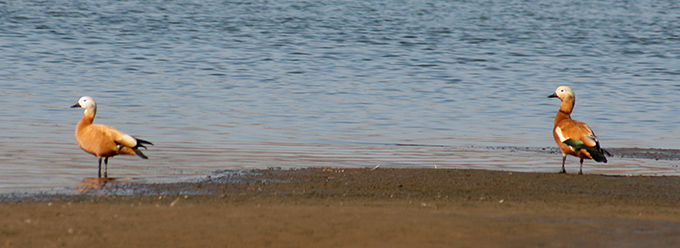

Jeju Island x Jeju Arboretum, wetlands and coast, February 23-24
I attended the Jeju Wildlife Research Workshop at Jeju City Arboretum on February 23. Presentations were given by people with expertise on wildlife, including reptiles and amphibians, Black-faced Spoonbill and Fairy Pitta. Two international researchers came from Taiwan to present some of their finding on Fairy Pittas and their habitat management and threats.
The formalities on Saturday were followed by a field trip to the west and southwest of Jeju Island with the prospect of finding an Oriental Stork. Unfortunately the bird wasn't found. We did see a Eurasian Spoonbill with some Grey Herons sheltering behind some trees from the cold wind. On a manmade wetland we saw 8 species of ducks, Coots, Little Grebes and a Red-throated Loon. Along the coast were many gulls, mostly Vega Gulls and Black-tailed Gulls with a few Slaty-backed Gulls. Other birds seen along the coast were Great Cormorants, Little Egrets, Pacific Reef Herons, Great Crested Grebes and Black-necked Grebes.
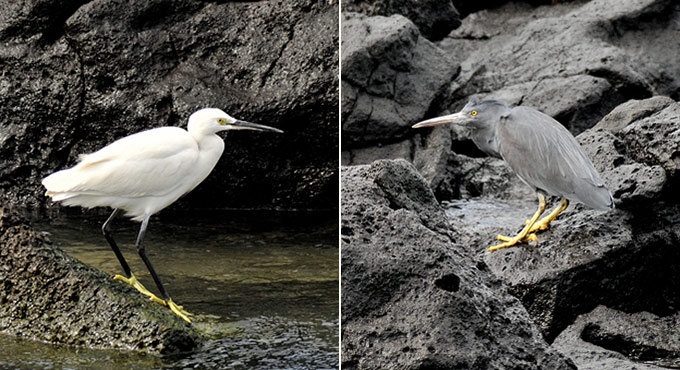
On Sunday February 24 we met again at the Arboretum and walked around looking for birds. An abundance of seeds attracted some seeding eating species including Japanese Grosbeaks, Hawfinch, Oriental Greenfinches and Siskins. Foraging on the ground were Rufous Turtle Doves, Ring-necked Pheasants and Pale Thrushes. Other birds in the area included Brown-eared Bulbuls, Black-billed Magpies, Great Tits, Japanese White-eyes and Large-billed Crows. We also found 3 Black-throated Loons near the southeast corner of the island sheltering in a small harbour. We also saw an oiled juvenile Vega Gull in this area among the many gulls present.



From the Arboretum we were taken to the south coast where we found more Japanese White-eyes, Korean Bush Warblers, Blue Rock Thrushes, White Wagtails Motacilla alba lugens, Grey Wagtails, Common Sandpiper, Green Sandpiper, Daurian Redstart and a Pacific Diver. Around the eastern end of the island we saw Black-faced Spoonbills, Great Egrets, Little Egrets, Common Shelducks, Gadwalls, a Greater Spotted Eagle and 5 Grey Plovers at Seongsanpo. One male Gadwall was albinistic. A Black-throated Loon and a Pacific Loon that were oiled and beached washed. Besides seeing gulls along the east coast we found 2 Pelagic Cormorants and many Temminck's Cormorants.
In a wetland near the northeast corner of Jeju Island was a large wetland with many waterbirds. Besides the many ducks there were Bean Geese and a Lesser White-fronted Goose, some Northern Lapwings, a Peregrine Falcon and an Eastern March Harrier.
Along the northeast coast in the late afternoon we found more interesting birds, including Eurasian Wigeons, Long-billed Plovers, Kentish Plovers, Dunlin, a Black-legged Kittiwake and an adult Glaucous Gull.
I saw 69 bird species during the weekend and I know other species were seen. I think everyone there enjoyed the hospitality of the hosts during the weekend. Jeju Island is definitely worth a trip in winter.




Northeast River, February 24
A frigid morning in the river valley. The highlight was 2 pairs of Scaly-sided Merganser. Nearby, 5 Goldeneye, and 3 Tufted Duck fed near the river bank. Further down the river, 6 Spot-Billed Duck and 4 Little Grebe drifted in the current. In a nearby stream, a pair of Brown Dipper fed and dunked each other in a small waterfall. While their alarm call is short and harsh, when calling to one another they have a beautiful, complex warbling song. 2 Japanese Wagtail were also in this stream. All day, large, noisy mixed flocks of 20-50 Rustic and Yellow-throated Bunting moved through the trees and underbrush along the river. Groups of Vinous-throated Parrotbill were also evident in the underbrush. An Eurasian Nuthatch, and a Great Egret were also seen.

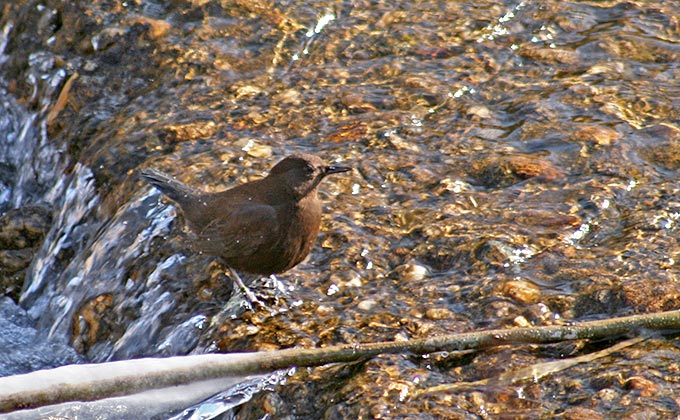

Geum tidal area, Seo-seong reservoir, February 24
At the Keum a Ruddy Shelduck was a personal first at this site for both PN and myself. A couple of Eurasian Widgeons, a few Northern Lapwings, a single Eurasian Oystercatcher and a few Red-breasted Mergansers were there as well. Saunders's Gulls are still numerous; a few hundred were landing on the mud as it re-emerged in the afternoon. Near Napo a Great Bittern (perhaps the same individual as before) was noticed in a ditch. Also still hanging around, a Ferruginous Duck was in the Seo-seong reservoir. A single male Pallas's Rosefinch was seen in a woodlot. At the base of Oh-seong a Grey Wagtail and an apparent wintering Common Moorhen were observed. A Pale Thrush was seen briefly retreating into the brush.
Suncheon and Gwangyang, February 23
Just a short trip to a very windy Suncheon to check on the cranes gave views of 3 Common Crane, 150+ Hooded Crane, a juvenile White-naped Crane and at least one Hybrid. While watching the crane, I got brief views of only my second Siberian Weasel. An even shorter stop at a field on the way home yielded a few Eurasian Siskin, Meadow Bunting, Olive-backed Pipit, 1 Eurasian Sparrowhawk, 1 Goshawk, 1 Pale Thrush and 1 Red-flanked Bluetail, among other more common species.



Field near Baekseok Station, Ilsan, February 22
About 24 Ruddy Shelduck were seen in the fields near Baekseok Station on Friday.
Song Do-Sihwa-Uiwang, February 22
The last day of the tour, and again dry and largely sunny throughout, with unexpectedly mild temperatures (with a minimum of 3 or 4 C and a maximum of 9 C). At Song Do, some reclamation (i.e. destruction) now ongoing of a narrow strip of the remaining tidal-flat, set within other vast reclamation projects. Highlights at this highly threatened yet internationally important wetland included a Pied Avocet, 2 First-winter Relict Gull and over 100 Saunders's Gull, 7700 Dunlin and at least 800 Eurasian Curlew. At Sihwa Reclamation Lake, 70 Ruddy Shelduck and a good assortment of raptors including two large and pale Upland Buzzard, these the 174th (Swedish Checklist) or 179th (IOC/Birds Korea Checklist) and the last additional species of the tour. At Uiwang, sadly no sign of the Snow Goose, believed present until the 21st, with best there over 1000 Bean Geese.
(On 23rd, one Rough-legged Buzzard seen on the way to the airport by the group, on the outskirts of Incheon city).
Jeju Island (Seongsan Po-Hadori), February 21
Another very good day, in excellent weather, with clear skies, no wind, and the temperature soaring to plus 17C (almost 35 C warmer than dawn on the first full day of the tour!). Highlight of the day was excellent views of 14 of the 17 Black-faced Spoonbill at Seongsan Po, an internationally important wetland threatened with conversion to a speed-boat lake, with other birds of especial note including the Lesser White-fronted Goose still, 5 Cinereous Vulture, single Pacific Reef Egret and 4 Pacific Loon (several oiled, along with several Black-throated Loon and gulls), 5 Japanese Quail and 2 Chestnut-eared Bunting, a highly unexpected Eastern Marsh Harrier at Hadori, and very unseasonal Korean Bush Warbler (1), Richard's Pipit (1) and Eastern Yellow Wagtail (2). A further moment of interest involved a close (and slightly bloody-fingered!) encounter with a Great Cormorant (released successfully after it had become entangled in discarded fishing nets), one of several seen very well during the day.


Pohang, February 20
Best along the coast at Dogu-ri, 2 presumed pallidissimus Glaucous Gull, appearing distinctly larger and more powerfully built than a smaller barrovianus (?) seen a week earlier at Hwajinpo. Otherwise little of note- the usual assemblage of Vega,Common, Black-headed, Slaty-backed and Black-tailed gulls, (one of which was oiled). On the sea, Several Great Crested and a Black-necked Grebes, a handful of Red-breasted Merganser, and groups of Siskins and Oriental Greenfinches nearby.
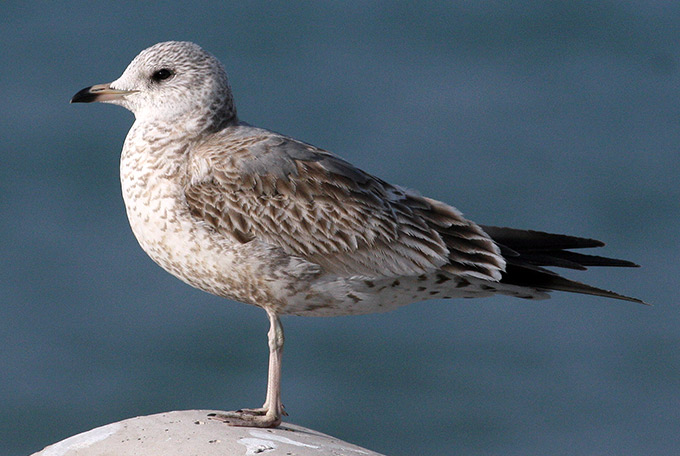



Jeju Island, February 20
In rather milder conditions, birding at various wooded sites in Jeju City, and then at the east coast. In Jeju City, outstanding highlight was 21 Japanese Grosbeak at Halla Arboretum (thanks to Mr. Kim Wan-Byung), where also several Pale Thrush and Red-flanked Bluetail (4) well-seen, though only one Grey Bunting heard, and 20 Chinese Grosbeak in other city parks. At Hadori, a single Pacific Loon with ca 20 Black-throated Loon (several of which were stained with oil), and an outstanding 20 minute spell which included 2 Black-faced Spoonbill and a close encounter with an Oriental Stork (the latter flushed by a passing Greater Spotted Eagle), soon followed by very decent views of a first-winter Lesser White-fronted Goose. In addition, of especial note were no less than 3 Eastern Yellow Wagtail, with one taivana (a first winter) seen well and distantly photographed.






Stream and hill near Baekma train station, Ilsan, February 20
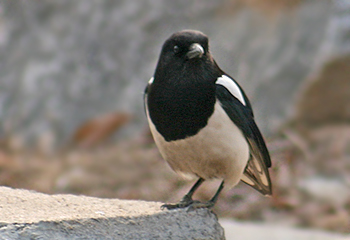
On a warm and sunny day, 2 Green Sandpiper were stillpresent at the stream, as were 2 scruffy lugens White Wagtail. At least 6 Common Snipe were also there, showing the white trailing edge to their secondaries, as they were repeatedly flushed by regular foottraffic along the river. 2 Naumann's Thrush with quite different plumage were seen next to the stream. One had a dark gray tail and rump, while the other had a rufous tail and rump. An odd sight was a Eurasian Magpie that was missing its tail. It had an understandably hard time balancing on branches, and presented a strange silhouette.
On a nearby hill, 2 Grey-capped Pygmy, and 1 Grey-headed Woodpecker were present. I was also quite startled to come face to face with a large buck deer, that didn't seem too happy to see me!




Junam, February 19
A privileged look at the 2 drake Baer's Pochard, one of Asia's rarest and most threatened birds, in late afternoon found them dozing among a spread of Common Pochard, before becoming restless and winging away at dusk. Just prior, a startled Great Bittern was accidentally flushed and gave close flight views before crashing clumsily back into the reeds. Other waterfowl included good numbers of Falcated Duck, Smew, Coot, up to 10 Common Moorhen, and c.40 Whooper Swan. A dense pack of Shoveler were feeding in a co-ordinated rotating mass. A flock of Siskin could be seen hungrily devouring seed pods. Other birds included several Black-faced and Yellow-Throated Buntings, keeping out of sight of a Eurasian Sparrowhawk.


Nakdong Estuary, February 19

Photo © Nial Moores
Threatened by a huge range of major development projects (including the ongoing Miyeonji road bridge, the New Port and construction of apartments at Miyeonji, as well as a possible new airport and the terribly ill-advised Grand Canal), the Nakdong Estuary now supports far fewer birds than in previous years, though still some excellent species remain. Highlights of a very good day in the field in gradually warming conditions were 9 Relict Gull (perhaps 8 first winters and one second winter), 2 Swan Goose, and 2 (or 3) Steller's Sea Eagle, including excellent views of a soaring adult against a cloudless sky. Other species of note there included probably 7 White-tailed Eagle, 3 Short-eared Owl, Japanese Bush Warbler, c 10 Pale Thrush, a briefly heard Red-flanked Bluetail and Long-tailed Rosefinch, and a Japanese Quail.

East Coast, February 16-18
Feb. 16: -en route. Near Yang Yang, the 2nd Steller's Eagle of the day after Pete and Angela saw one on the way to Gwangneung. A little farther north, a Rhinocerous Auklet, a Long-billed Murrelet, and several Ancient Murrelets. 2 White-tailed Eagles.
Feb. 17: Hwajinpo. Somewhat rough viewing conditions but many excellent birds. 5 Siberian Accentors near the Pension. Another White-tailed Eagle. Seawatching highlights: small numbers of of Black-throated Loon and Black-necked and Great Crested Grebes, 1 Red-necked Grebe. 1 distant likely Thick-billed Murre. Small numbers (about 15) of Ancient Murrelets. White-winged and American Scoter both frequent. Goldenyes. 5 Harlequin Ducks giving excellent views. 1 fly-by Black Brant. The picturesque rocks near the lighthouse held several Glaucous and 1 adult Glaucous-winged Gull basking in late afternoon light. At the Daejin Harbour we were approaching the flock of Greater Scaup (see T.E.'s report) when Angela noticed that Azure-winged and Black-billed Magpies were kicking up a fuss: they had found us a Ural Owl. Soon after, 6 local Grandmoms and 2 Grandpas saw the owl through my camera.
Feb. 18: morning only. 2 Pallas's Rosefinch and 2 Naumann's Thrush. A Eurasian Sparrowhawk. Some fine sea-watching, despite a complete dearth of Ancient Murrelets: 3 Spectacled Guillemots, ranging from semi to full breeding plumage, 1 Rhinocerous Auklet and 1 Long-billed Murrelet. A quite distant group of Murres appeared to be 7 Common Murres and (with somewhat less certainty) 2 Thick-billed Murres. 3 Black-legged Kittiwakes gave excellent views. Most excitement was a brief look at what appeared (allowing for considerable distance) to be breeding-plumage Pigeon Guillemot: an all-black Guillemot with a bright and broad slash of white wing patch. Angela and Heesun saw a female Blue Rock Thrush and 2 White Wagtails while we were busy auking.

Guryongpo, February 18
At the harbour a Long-billed Murrelet gave distant but clear views, picked out almost immediately by its characteristically upright posture in the water: nearby, a Rhinoceros Auklet and 5 Ancient Murrelet. Also on the ocean, 3 White-winged Scoter, 1 Red-throated, 2 Black throated and 1 Pacific Diver, the latter distinguished by distinctly shorter bill, fairly obvious when in direct comparison with Black-throated.
4 Black-necked Grebe dived among the incoming fishing boats, giving an emphatic drawn-out whistle when nervous. On the seashore rocks, a Common Sandpiper and Blue Rock Thrush.

Hwaum Sa, SE River and the Joonam Reservoirs, February 18
A quality day, enjoyed in warm sunshine, with temperatures rising from minus 7 C at dawn in Iksan to plus 8 or 9 C at Joonam. At Hwaum Sa, 4 Hill Pigeon, single White's Thrush and Pale Thrush (the latter seen very well), Brown Dipper and Tristram's Bunting (heard by NM and seen by one observer), and at the SE River, 23 Mandarin Duck (feeding on midges on the water surface and by diving, perhaps for insect larvae?) and still 2 Plumbeous Water Redstart. Outstanding highlight of the day came at the Joonam Reservoirs, however. After fantastic views of species such as Bean Goose and Eurasian Spoonbill (ca 20), and good comparative views of alba and modesta (Eastern Great Egret), likely the species of the tour so far came in the form of two male Baer's Pochard, watched very well in the warm evening light. Baer's Pochard appears to be in rapid decline, and this is the first record of the species in Korea known to Birds Korea for several years.


Yongsan river barrage, February 18
While on a drive by a quick look to both sides of the barrage made me stop and showed on the lake side of the barrage 300-350 Coot some Little Egret and 4 Great Cormorants on a small construction platform while on the seaside about 100+ Great Cormorants were in the water accompanied by about 30 Vega Gulls.
Cheongcho Lagoon, Gyeongpo lagoon and Namdae Cheon, February 17
Cheongcho Lagoon.
On February 17 I was in Sokcho and took the opportunity to check out the birds at Cheongcho Lagoon first thing in the morning. Very favourable light allowed me to get some photos while I was there. There were plenty of ducks on the lagoon including, Mallards, Tufted Ducks, Greater Scaups, Common Pochards, Common Goldeneyes, Common Mergansers, Smew and 2 Pintails. And just as I was leaving a flock of Spot-billed Ducks flew in from the west along the stream. There were also Great Crested Grebes, a Little Grebe, Black-headed Gulls, Black-tailed Gulls, Vega Gulls, Slaty-backed Gulls and a Glaucous Gull. Around the edge of the lagoon were 35 Great Egrets, 30 Grey Herons, 5 Little Egrets, 9 Northern Lapwings, 35 Great Cormorants and about 25 Sanderlings.




Namdae Cheon
We had a brief look at the lower reaches of Namdae Cheon in Yangyang as we headed south. There were large numbers of Spot-billed Ducks and Mallards on the water and ice. Other birds included Common Mergansers, Tufted Ducks, Gadwalls, Common Goldeneyes and a Common Pochard. There was also an immature White-tailed Sea Eagle resting on the ice near the sand bar.


Around Gyeongpo Lagoon
From there I travelled to Gyeongpo Lagoon in Gangneung. The wind had increased and was very cold making conditions uncomfortable for birding. The lagoon had large numbers of Mallards and Common Mergansers, significant numbers of Great Crested Grebes, Smew, Greater Scaups, Coots, Pintails, Black-tailed Gulls and Vega Gulls, and also some Common Teal, Little Grebes and Common Goldeneyes. Roosting on the island were significant numbers of Grey Herons and Great Egrets. Among them there was a Spoonbill sleeping that I think was a Eurasian Spoonbill. There were more ducks in the cannal that connects the lagoon to the sea. When we checked for the Spoonbill later it was gone.
Around the ponds near where the river meets the cannal there were some forest birds including Great Tits, Long-tailed Tits, a Coal Tit, Yellow-throated Buntings, Rustic Buntings, 2 Little Egrets, 2 White Wagtails (M. a. lugens), 3 Bullfinches, a Brambling and a Great Spotted Woodpecker.
The increased number of Herons and Egrets could suggest the northward migration of these birds to summer breeding sites.


Saemangeum and Geum River, February 17
With temperatures remaining cold (minus 8 at dawn, rising to only 2 C in the afternoon), the day's biggest surprises were the lack of Swan Geese at the Geum (already moved north?), the 100,000 or so Baikal Teal which flew up river in the mid-afternoon, and the 6,000 Rook which seemed unexpectedly restless and keen to soar. Best birds of the day included several Chinese Penduline Tit, 2 osculans Oystercatcher and excellent views of up to 150 Saunders's Gull (at the Geum Estuary), as well as a single Rough-legged Buzzard and a flock of 240 Rustic Bunting at the Geum River.
Han River and Lake Park, Ilsan, February 17
A poorly planned walk to the Han River on a sunny, windy, and pleasant day. Didn’t stay long, because there was no direct access to the river, as the whole area was fenced off and guarded by wary soldiers. In a large field next to the river was a flock of ca 150 Greater White-fronted Geese, and 6 Cinereous Vulture circled nearby.
In Lake Park, a Bull-headed Shrike was sitting on a fence. A Pale Thrush was creeping around in the undergrowth on a hill, the first I’ve seen in winter. 1 male and 1 female Daurian Redstart were mingling with a group of Tree Sparrow. Nearby, 3 Varied Tit were doing their best woodpecker imitation, pecking at tree bark. 3 Japanese Quail are still in a large field adjacent to Lake Park, flushed twice by a very small dog. Also in this field was a flock of at least 30 Far Eastern Skylark, flying erratically together after being spooked by a female Eurasian Sparrowhawk.


Anyang-chun, February 16
My wife and I saw a Water Pipit from February 13 to 16 in the Anyang-chun (creek).

Seosan lakes, Boryeong, Mangyeung, February 16
With temperatures falling to minus 9 at dawn, highlights during another very good day included 3 Oriental Stork at Seosan (out of a total of 6 there, with a further 11 present in Gomso Bay area: latter news via Kim Su-Kyung), along with 4 Hooded Crane and 9 Rough-legged Buzzard there; and approximately 100,000 Baikal Teal watched in excellent light with several very close individuals (both males and females) at Mangyeung, along with the first Olive-backed Pipit (15) and White-cheeked Starling of the tour.
Gimpo, February 16

A relatively extensive (and mercifully undeveloped) area of overgrown scrub, boggy grassland and reeds alongside the Han river has supported a roost of no less than 6 Short-eared Owl this winter. Although the carloads of assembled photographers all reported failing to see any today, I virtually walked straight into a particularly approachable individual as I headed home, quite unbothered that I had frozen literally only 2 metres from it. It later took to hovering and hunting in its typically fluttering and gliding manner.
In nearby woodland, yet another Eurasian Treecreeper. Although rare to virtually absent in previous years, they have been widespread and numerous throughout the North and North-west at least, since early November last year.
Nearby, several Brambling, and on the river a handful of Ruddy Shelduck.

Hwajin Po, Yangyang, Jumunjin, Okgye, February 15
With much milder temperatures of minus 3 C at dawn, rising to possibly plus 4C during the day, time spent searching for a few key species. Highlights included further very good views of Long-billed Murrelet (3) near Hwajin Po (along with another unidentified large murre), 2 juvenile/first-winter Glaucous-winged Gull, a hybrid Glaucous x dark-winged gull, 4 White-tailed Eagle and excellent views of Pallas's Reed Bunting (15) at Yangyang.
Hwajin Po area, February 14
A great day of seawatching, including a three hour boat trip. Many highlights during the day, including excellent views of Spectacled Guillemot (with a minimum 9 or 10 seen, several in full breeding plumage), a total of 7 Long-billed Murrelet (the latter all from land), 2 Least Auklet, 3 Common Murre (and one unidentified), one Rhinoceros Auklet, and ca 1300 - 1500 Ancient Murrelet. Further highlights at the coast included 2 Long-tailed Duck, rather more Harlequin, 13 Siberian Accentor, 11 Pallas's Rosefinch, a Japanese Lesser Sparrowhawk, 1 Dusky and 2 Naumann's Thrushes, and a cachinnans-type Mongolian Gull.
Gangneung, February 14
Views from the beach in the morning added only 7 Black-necked Grebe and a Glaucous Gull.
Namhansan, Hanam, NE River, February 13
9 Pallas's Rosefinch (including one stunning adult male) and 2 or 3 White-backed Woodpecker started the day very well, followed by very good views of a (probably) 3rd calendar year and one adult Steller's Sea Eagle (both flushed by army helicopters), 4 Long-billed Plover, along with single Common Treecreeper and Rough-legged Buzzard (the latter both present this winter in exceptional numbers), and the first Pallas's Reed Bunting of the trip. On to the increasingly disturbed NE river, where 6 Scaly-sided Merganser were found away from their usual stretch, and then towards the coast, where 2 Brown Dipper were the last birds of the day.
Hwajinpo-Gangneung, February 13
More sea-watching from Kim Il-Sung's former hilltop pension revealed another pack of c.70 Black and 2 White-winged Scoter, a Smew , 4 Goldeneye and another Red-necked Grebe. From the lighthouse, a Slavonian Grebe, and groups of Mallard, Spot-billed Duck and Pintail curiously foraging in the rockpools.4 more Red-necked Grebe were distinguished by their somewhat flat-headed/downcurved bill impression,low-slung profile, greyish cheeks and overall grubby appearance.Also 2 Long-tailed Rosefinch in nearby scrub. At Gwangneung,brief seawatching turned up a flock of 14 Sanderling, 7 White-winged Scoter and a Pacific Loon. On Gyeongpo lake, 13 Greater Scaup, 10 Coot and 6 Goldeneye.
Dejin East coast, February 12
Main prize at the fishing harbour was an adult Glaucous-winged Gull showing its pallid primaries and oddly small eye: otherwise Slaty-backed and Vega Gulls pedominated, with 1 adult and a 1st winter Glaucous Gull. Lazing by the fishing boats, 53 Greater Scaup. Pelagic Shags and the odd Temminck's Cormorant draped themselves over the rocks, with 6 Harlequin diving in the surf. On the sea, alcids proved virtually absent- only 6 Ancient Murrelet. Otherwise, numerous Great-crested Grebes and Red-breasted Merganser, several males of which encircled a female with neck-stretching and head popping courtship displays. Also a raft of 92 Black Scoter, 1 Goldeneye, 3 White-winged Scoter, 2 Red-necked Grebe, 4 Black-throated Diver, several Black-legged Kittiwake, and a Black-necked Grebe. A fishing White-tailed Eagle far out to sea was follwed by another over the harbour: also in the sky, 1 Cinereous Vulture and 3 Common Buzzard ( including 1 rufuous form). Beside the guest house were 4 Siberian Accentor.



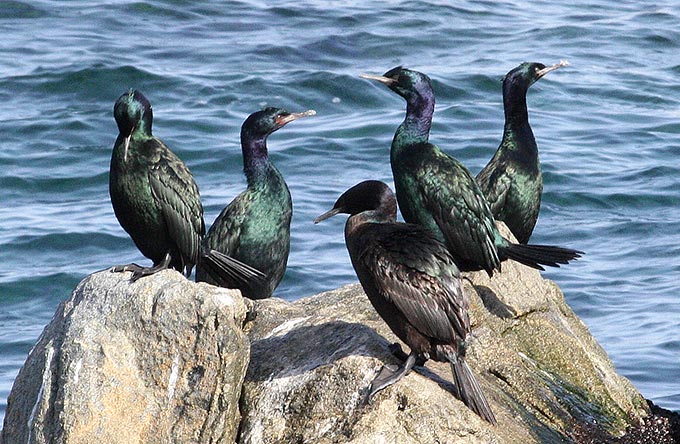
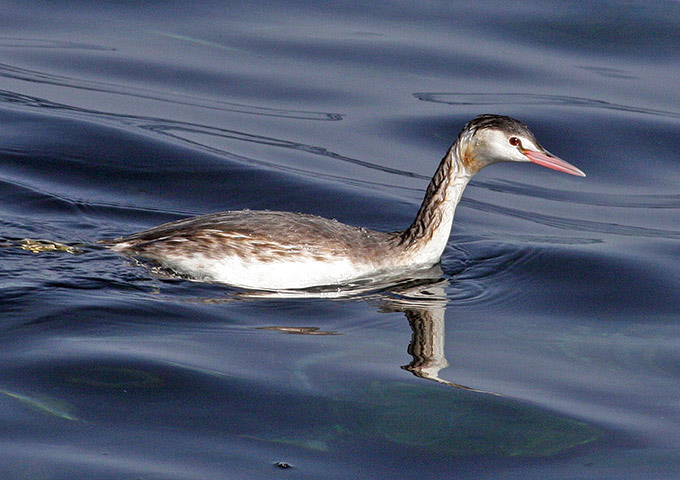
Stream near Baekseok Station, Ilsan, February 12
It was a cold and sunny day, although the yellow dust was high today, burning my eyes a bit. 3 scruffy Little Grebe were swimming in circles. Several Long-Tailed Tit were hanging out in some trees near the stream. A single female Common Merganser was swimming with a group of 10 Mallard, 8 Spot Billed Duck, and 2 female Common Teal. 2 Great Egret, a Grey Heron, and an unidentified Sandpiper were also seen today.


Gimpo, February 12
An afternoon trip in bracing cold weather. The massive Treecreeper influx continues: along the way from the subway to the River Park, a random stop in a small wooded strip yielded 3 of these delicate birds--the most vocal I have encountered this winter.
At the Han River Park, highlights were a Rough-legged Buzzard, a dozen Ruddy Shelduck, 5 Bean Geese, several Common Pochards, and a Short-eared Owl.



Cheorwon County and The National Arboretum, February 12
With a dawn high of minus 14 C and a maximum of minus 5 or 6 C, this was apparently the coldest day of the winter so far. At Cheorwon, under a blue sky made somewhat hazy with Gobi Yellow Dust, probably 130 White-naped and 50 Red-crowned Cranes, 150+ Cinereous Vulture (with more seen sitting in fields at Paju), 3 Baikal Teal, 6 White-tailed Eagle, a Chinese Grey Shrike and excellent views of a Siberian Accentor were the obvious highlights, while a hybrid Snow (neck, head and bill) x Greater white-fronted Goose (the remainder) was also of great interest. At the arboretum, great looks (in excellent light) at 3 Solitary Snipe, a Common Treecreeper, and good numbers of typical forest birds (including Varied Tit and Japanese Pygmy Woodpecker).
Yongsanho Agricultural Museum, February 12
A short morning trip with very cold and strong wind showed a flock of 80+ White-cheeked Starlings, 20+ Brown-eared Bulbul, several Azur-winged and Eurasian Magpies, 4 Rufous Turtle Dove, 9 Rustic Bunting and a few Eurasian Tree Sparrows. The trip ended abruptly due to a heavy snow shower.


Yeongjong Airport, February 11
In the hour or so of light remaining, 125 Falcated Duck and 2 Meadow Bunting provided a good start to the 12 day tour.
Chungju x rivers, February 10
On February 10, I walked from Chungju Railway Station along a stream that flows into Dalcheon near the Chungju Sewerage Treatment plant. The stream held a lot of Common Teal, Spot-billed Ducks, Mallards, Gadwalls, Wigeons and Tufted Ducks. There were more ducks in the sewerage ponds Falcated Ducks. Along the stream's flood banks I saw Dusky Thrush, Oriental Greenfinches, Japanese Wagtails, Tree Sparrowsand Daurian Redstarts.
Resting on the ice on Dalcheon were 4 Whooper Swans and Mallards. On the water of Dalcheon I saw more ducks including Pochards, Common Mergansers, Smew and others I'd seen in the stream earlier. Along the flood bank there were two Long-tailed Rosefinches.
After midday I walked around Tangeumdae and upstream along theNamhan River. Here I found 120 Greater White-fronted Geese resting on the water with Spot-billed Ducks. Further out in the river were Coots, Mallards, Great Crested Grebes, Common Mergansers and Smew. Resting on the island near Tangeumdae were some Grey Herons. Birds seen near the river and laterin the rice fields icluded Brown-eared Bulbuls, Great Tits, March Tits, Long-tailed Tits, Rufous Turtle Doves, Oriental Greenfinches and Far Eastern Larks.



Keum, reservoir near Seong-san and Samgi, February 10
Common Gulls were seen when we reached the Keum tidal area. Several female Red-breasted Mergansers were far off shore. A Winter Wren was in a park area. Falcated Ducks were in a short string a few hundred meters out. We met Chae Seung-hoon, who led us to an earlier encountered Great Bittern. We parted and went to a large reservoir near Seong-san. There, PN sighted a Ferruginous Pochard. Large groups of thousands of Baikal Teal were overhead as well as to my surprise present near Hwang Deung before dusk in the thousands. After parting ways with PN I met again with CSH, noted several hundred Saunders' Gulls and 40 of so Northern Lapwings (PN noted a site high 104+ on February 3rd.) at the Keum tidal area.

Paldang, February 10
A very, very bitter morning turned out to be a day of many blessings at Paldang. No sooner had I left the subway station yet was greeted by hundreds of Common Pochard, Tufted Duck, Mallard, Common Goldeneye, and Common Coot each respectively. As I scanned the rocks, encountered two of eight playful White-tailed Eagle. Big highlights of the day were a Smew, 60+ Whooper Swan, and the ever majestic Steller's Sea Eagle.
Guryongpo, x sea and coast, February 9
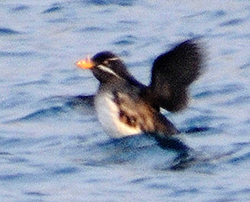
Photo © Barry Heinrich
I did some birdwatching around Guryongpo Harbour on Saturday February 9. There was a b cold northwesterly wind blowing and clear skies. I walked out to the end of the southern harbour wall around 9.30am and saw several small flocks of Ancient Murrelets diving near the northern harbour wall. There were a couple of different birds with them including a Rhinoceros Auklet. They were very active and the sea was choppy so photography was difficult but I managed to get some images useful for identification. Other birds seen in the area included Black-throated Loon, Great Crested Grebes, Black-tailed Gulls, Black-headed Gulls, Vega Gulls and Slaty-backed Gulls.
When I walked up to Guryongpo Beach later I found more gulls on the rocky shore at low tide. There were also some Sanderlings, Dunlin and Black-backed Wagtails feeding in the area. Two male Northern Pintails were resting on the rocks with the gulls. A pair of Red-breated Mergansers were seen diving around the rocks nearby. A beach washed Ancient Murrelet was on the sand at the high tide line.
Birds seen around the town included a Common Kestrel, Tree Sparrows, Siskins, Black-billed Magpies, Blue Rock Thrushes and Brown-eared Bulbuls.
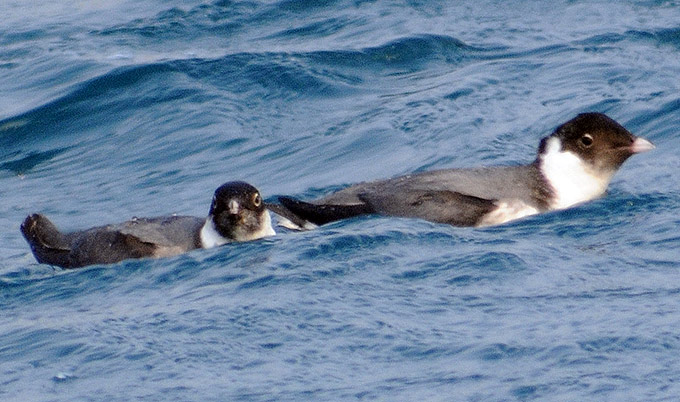




Iksan, February 9
A look at my favorite stream brought 16+ Green Sandpipers, a Black-faced Bunting, a Grey Wagtail, White Wagtails: 2 leucopsis and 4 or 5 lugens. Also Olive-backed Pipits and two Long-billed Plovers were seen.
Daejeon, February 8
I visited Daecheon in Daejeon on afternoon of February 8. I walked downstream along the river from Gapcheon subway station and then followed a smaller tributary upstream to Daejeon Train Station. The most abundant birds were Spot-billed Ducks and Common Teal. There were also Little Grebes, Common Mergansers, White Wagtails, Long-billed Plovers, Japanese Wagtails, Grey Herons, Littel Egrets, Gadwallsand Vega Gulls along the river. Flying overhead was a Rough-legged Buzzard. Birds near the river included Eurasian Magpies, Vinous-throated Parrotbills, Pigeons and Great Tits. At one of the weirs there was a Black-crowned Night Heron resting on a rock.
Along the tributary I saw some other species, including Mallards, Northern Pintails and Northern Lapwings. As dusk approached I saw a Common Kestrel harrassing bird sitting on a metal fence post. Unfortunately the bird flew before I could get a photo. It was a Short-eared Owl. Several more Grey Herons and Black-crowned Night Herons flew downstream as the light faded after sunset.
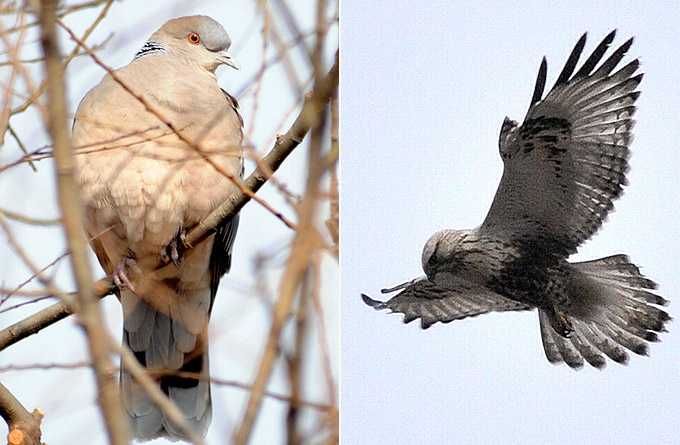
Photos © Barry Heinrich


Songdo, February 8
The Pied Avocet performed well to an appreciative gathering of onlookers, prancing through the shallows with exaggerated side-sweeps of its bill: this appears to be an overwintering individual, first photographed here on November 12th 2007 (birdDB.com website) and intermittently since. It is also the 2nd record for Songdo, after the first here on Oct. 7th 2006.
On the last unreclaimed tidal flat, 200+ Saunders's Gull fluttered like butterflies over the mud: also c.260 Dunlin, 650 Eurasian Curlew, a handful of Common Gulls and 1 very oiled Black-tailed Gull.

Geum-ji and Yang-ji Reservoirs (10 minutes north of Maisan), February 8
Several groups of Pallas's Rosefinch were seen on a 1km walk between the reservoirs. Japanese Wagtails, a Common Snipe, some Meadow Buntings and a couple of Winter Wrens were also seen on a walk on the 7th, heard again on the 8th.

Seoul and Incheon, February 6 and 7
A couple of holiday forays. On February 6, a short visit to Dobongsan (lower reaches) yielded highlights of 1 Treecreeper, 1 Eurasian Nuthatch, and a flock of 5 Long-tailed Tits with 1 white-headed type tagging along.
On the 7th, a trip to Incheon's Songdo with the intention of checking the (obviously threatened) status of Relict Gulls along the mudflats that have all but disappeared at Songdo. However, a scan of the brackish "inner area" proved distracting: a beautiful Avocet was busy scything the shallows, a couple thousand Pochards and several hundred Common Shelduck in the background.
By the time I could tear myself away from the Avocet, the tide had come in surprisingly high, and the majority of gulls were too distant (a beach in the military zone) for positive i.d., although one looked suspiciously like a Relict in terms of behavior. Of interest closer in was a single Black-tailed Godwit near a small flock of Black-headed Gulls.

Han river, February 6
Clear, cold and bright at Paldang, where the Ferruginous Pochard was frolicking amongst c.2000 Common Pochard. First found by Mr Kwak Ho Kyoung on Jan.29th, this becomes only the 5th national record after the first in 2002, and is possibly the same individual recorded here last winter. Numbers of Coot have swelled to 360 along this stretch: also 400+ Tufted Duck, 150 Goldeneye, 70 Whooper Swan, and the usual small group of whistling Wigeon. Notable were single overwintering Common Sandpiper & Little Egret, with suddenly abundant lugens White Wagtails. The new station at paldang has resulted in an influx of hikers and day-trippers to this picturesque spot, complete with new restaurants etc opening up. Nevertheless a long walk downriver found the superb adult Steller's Sea Eagle in his typical spot, along with 4 White-tailed Eagle and unbeatable close views of a Rough-legged Buzzard.
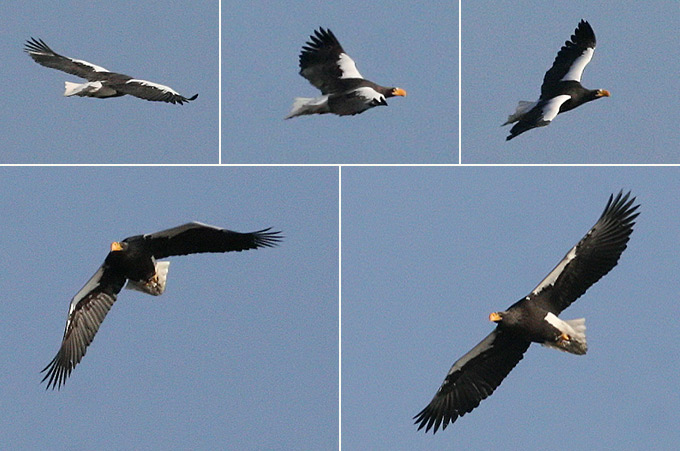
Uiwang, February 5
In sub-zero conditions, 1450 serrirostris Bean Geese huddled together on the icy reservoir: in amongst, a beautiful adult Snow Goose (first found by Mr. Kwak Ho-kyong), which seemed both less wary and more aggressive as well as more inclined to sleep than its noisy neighbours.
Plentiful commoner winter wildfowl were present, including a presumed Mallard X Spot-billed Duck/Gadwall hybrid, a lone Smew and 12 Coot.
In bushes and fields round about, a mixed flock of Rustic and Yellow-throated Buntings, several Naumann's Thrush and a Far Eastern Skylark ( identified by repeated rasping/buzzy "zhweeip" call".)



East Coast Lagoons, February 3 and 4
I visited Cheongcho Lagoon in Sokcho on February 3 and Gyeongpo Lagoon on February 4 to see what birds I could see. A cold wind was blowing in the late afternoon at Cheongcho Lagoon. A bird I hadn't see there before was a Red-throated Diver. There were over 400 Kamchatka Gulls resting on the sand spit, along with Great Cormorants, Grey Herons and other gulls including Black-headed Gulls, Black-tailed Gulls, Glaucous Gulls, Vega Gulls and Slaty-backed Gulls. Several species of waterbirds were also on and around the lagoon including 120+ Mallards, Greater Scaups, Tufted Ducks, Smew, Common Mergansers, Common Goldeneye, Common Teal, Great Crested Grebes, Little Grebes and 4 Nrothern Lapwings. An immature White-tailed Sea Eagle caused quite a lot of disturbance amongst the gulls when it was circling overhead.
It was cold and clear at Gyeongpo Lagoon next morning. There were more than 700 Mallards in the lagoon mostly in the southwest corner to gain some protection from the cold wind. Other ducks on the lagoon included Common Goldeneyes, Greater Scaups, Smew, Pintails, Spot-billed Ducks and Common Mergansers. There were also Great Crested Grebes, Little Grebes and Coots. On the island were some Grey Herons and Great Egrets. There were Black-tailed Gulls, Vega Gulls, Kamchatka Gulls and Glaucous Gulls as well. There were more Mallards, Smew, Pintails, Spot-billed Ducks and Common Teal along the river. I found several species in and around the ponds near where the river flows into the channel that connects the lagoon to the sea. These included more Grey Herons, Great Egrets, Little Egrets, a Grey-headed Woodpecker, a Great Spotted Woodpecker, Dusky and Naumann's Thrushes, Brown-eared Bulbuls, a Bull-headed Shrike, Rustic Buntings, Yellow-throated Buntings, Oriental Greenfinches, Bramblings, Bullfinches P. p. rosacea, Tree Sparrows, Vinous-throated Parrotbills, Great Tits and Rufous Turtle Doves.





Samgi and Iksan, February 3
A Goshawk was seen. Short-eared Owl 1. Grey-headed Bunting pair still around in same stream. Peregrine Falcon on the 30th.
Lake Park, Ilsan, February 2
Some interesting bird activity in Lakepark, on a partly cloudy and crisp day. Saw a shy but loud Winter Wren darting in and out of some reeds. Spotted a Common Moorhen skulking in the bushes near an unfrozen spot in the ice. A flock of agitated Tree Sparrow alerted me to the presence of a patrolling Eurasian Sparrowhawk. While walking next to a large field full of tall, dead grass near Lake Park, I was thoroughly startled when 3 Japanese Quail dramatically burst from the grass five feet in front of me. Several Pallas's Reed Bunting were also in this field. Other birds seen today were a single male Daurian Redstart, 6 Yellow-Throated Bunting, 2 Naumann's Thrush, and several Eurasian Magpie.





News received by Birds Korea on February 1st from Dr. Christoph Zockler (ArcCona Ecological Consulting), Kashiwagi Minoru (JAWAN) and from Wildbird Adventure Travel and Tours
An incomplete survey of two extensive inter-tidal areas in the Burmese part of The Bay of Bengal has just been completed by fourteen members of the Spoon-billed Sandpiper Recovery Team and support organizations in late January 2008. The survey found at least 84 Spoon-billed Sandpiper Eurynorhynchus pygmeus, which is apparently the highest confirmed national count of this now Critically Endangered species in its over-wintering range, which spans from coastal Viet Nam, through the Inner Gulf of Thailand, west to the Bay of Bengal. At Arakan, 35 Spoon-billed Sandpiper were found at a single high-tide roost (presumably the largest concentration recorded in the world since the closure of the Saemangeum seawall in 2006), with one first-winter bird there photographed with a light blue leg-flag indicating it was banded in North Chukotka in summer 2007. A further 48 Spoon-billed Sandpiper were found dispersed over the tidal-flats of Martaban.
Further details (and acknowledgements) will be posted later, as part of an international press-release that will highlight the dependence of this highly charismatic species on extensive and dynamic estuarine areas. Such areas, whether in the Yellow Sea, the Inner Gulf of Thailand or in the Bay of Bengal are essential habitat for internationally important concentrations of birds, for threatened species, and for an enormous number of local fishing communities.

Photo © The Spoon-billed Sandpiper Recovery Team
Nakdong River, February 1
Today while birding along the Nakdonggang River I saw what is without a doubt a winter plumaged Temminck's Stint. Judging by its range map, and the checklist on Birds Korea I believe this is a significant record. This small shorebird was feeding along the sandy shore along the one side of the river, on a sandy beach about 800 meters long, and 150 meters wide. It was feeding close to the bridge that crosses the river at that area. The stint was noticeably smaller than the 6 Dunlin that were feeding like sewing machines nearby. It had yellow legs, a short black bill, and had greyish brown upperparts. There was no streaking on the breast, it lacked a white supercilium, and had no distinct field mark that might rule out this species. To be honest, it looks exactly like the picture in The Birds of Korea Field Guide. I observed the bird for about 45 minutes, in good light, sometimes at a distance of only 10 meters. Exact coordinates from Google Earth are 35 degrees 48'39 North, and 128 degrees 28'14 East.
Other interesting birds in the area were 2 Common Shelduck, 2 Smew (male and female), 15 Buff-bellied Pipits, 12 Long-billed Plover, 4 Lapwing, 1 Pochard, 1 Great Spotted Woodpecker, 2 White-backed Woodpecker, 1 Bull-headed Shrike, 10 Vinous-throated Parrotbill, 6 Siskin, 1 Brambling.
Paldang, February 1
A trip to Paldang to search for a Ferruginous Duck reported by Mr. Kim Dong-won on KWBS (thanks T.E. for the tip!) for what seems to be a second straight year there was successful--a very handsome, dark chocolate, longbeaked, highheaded, apparently pure-bred Ferruginous floating (and diving frequently) among the many hundreds of Pochards. A White-tailed Eagle dozed on a rock just behind the ducks. Smaller numbers of Tufted Ducks, Goldeneyes, Common Mergansers, and a single male Smew added to the mix, and a Eurasian Sparrowhawk flashed by and landed in a riverside thicket.


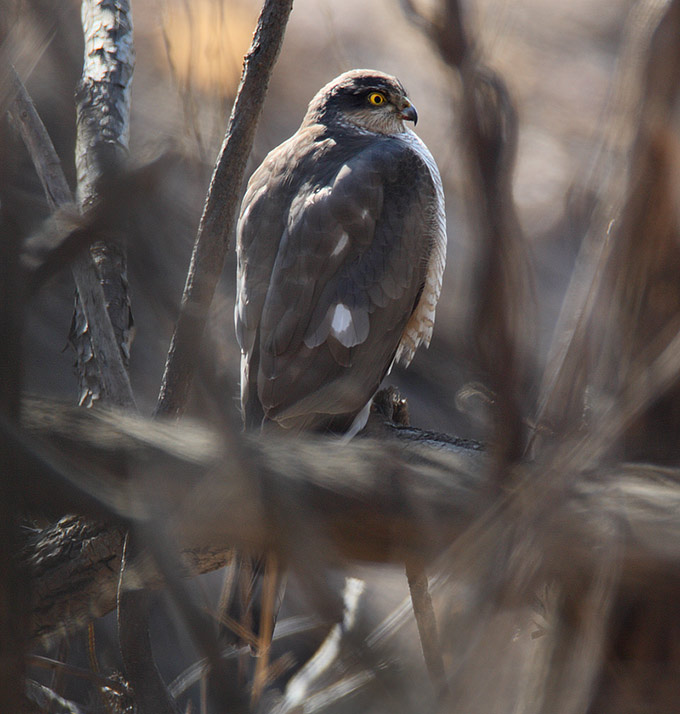
Mokpo Hadang Waterfront, February 1
Beside the daily coming Grey Heron and Little Egret on lowering tide a Little Grebe was seen and also a Coot for the second day. On the rocks a female Blue Rock Thrush could be observed for quite some time in very close range.






